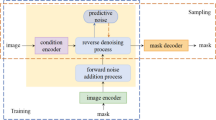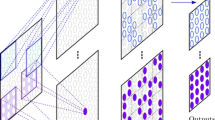Abstract
Segmentation of brain MRI images becomes a challenging task due to spatially distributed noise and uncertainty present between boundaries of soft tissues. In this work, we have presented intuitionistic fuzzy set theory based probabilistic intuitionistic fuzzy c-means with spatial neighborhood information method for MRI image segmentation. We have investigated two well known negation functions namely, Sugeno’s negation function and Yager’s negation function for representing the image in terms of intuitionistic fuzzy sets. The proposed approach takes leverage of intuitionistic fuzzy set theory to address vagueness and uncertainty present in the data. The spatial neighborhood information term in the segmentation process is included to dampen the effect of noise. The segmentation performance of the proposed method is evaluated in terms of average segmentation accuracy and Dice score. Further, the comparison of the proposed method with other similar state-of-art methods is carried out on two publicly available brain MRI dataset which shows the significant improvements in segmentation performance in terms of average segmentation accuracy and Dice score. The proposed approach achieves on average 91% average segmentation accuracy in the presence of noise and intensity inhomogeneity on BrainWeb simulated dataset, which outperformed the state-of-art methods.













Similar content being viewed by others
Notes
IBSR [online], available: https://www.nitrc.org/projects/ibsr
Brain Extraction Tool (BET) [online], available: http://www.fmrib.ox.ac.uk/fsl/.
References
Ahmed MN, Yamany SM, Mohamed N, Farag AA, Moriarty T (2002) A modified fuzzy c-means algorithm for bias field estimation and segmentation of mri data. IEEE Trans Med Imaging 21(3):193–199
Akkus Z, Galimzianova A, Hoogi A, Rubin DL, Erickson BJ (2017) Deep learning for brain mri segmentation: state of the art and future directions. J Digital Imaging 30(4):449–459
Atanassov KT (1986) Intuitionistic fuzzy sets. Fuzzy Sets and Systems 20(1):87–96. https://doi.org/10.1016/S0165-0114(86)80034-3, http://www.sciencedirect.com/science/article/pii/S0165011486800343
Balafar M, Ramli AR, Saripan MI, Mahmud R, Mashohor S, Balafar M (2008) New multi-scale medical image segmentation based on fuzzy c-mean (fcm). In: 2008 IEEE Conference on innovative technologies in intelligent systems and industrial applications. IEEE, pp 66–70
Bezdek JC (1981) Pattern recognition with fuzzy objective function algorithms. Kluwer Academic Publishers
Bezdek JC (2013) Pattern recognition with fuzzy objective function algorithms. Springer Science & Business Media
Bezdek JC, Douglas Harris J (1978) Fuzzy partitions and relations; an axiomatic basis for clustering. Fuzzy Sets Syst 1(2):111–127
Bezdek JC, Hall L, Clarke L (1993) Review of mr image segmentation techniques using pattern recognition. Med Phys 20(4):1033–1048
Brandt ME, Bohant TP, Kramer LA, Fletcher JM (1994) Estimation of csf, white and gray matter volumes in hydrocephalic children using fuzzy clustering of mr images. Comput Med Imaging Graph 18(1):25–34
Cabezas M, Oliver A, Lladó X, Freixenet J, Cuadra MB (2011) A review of atlas-based segmentation for magnetic resonance brain images. Computer Methods and Programs in Biomedicine 104(3):e158–e177
Cai W, Chen S, Zhang D (2007) Fast and robust fuzzy c-means clustering algorithms incorporating local information for image segmentation. Pattern Recogn 40(3):825–838
Chaira T (2011) A novel intuitionistic fuzzy c means clustering algorithm and its application to medical images. Appl Soft Comput 11(2):1711–1717
Chen S, Zhang D (2004) Robust image segmentation using fcm with spatial constraints based on new kernel-induced distance measure. IEEE Trans Syst Man Cybern Part B (Cybernetics) 34(4):1907–1916
Chintalapudi KK, Kam M (1998) A noise-resistant fuzzy c means algorithm for clustering. In: 1998 IEEE International conference on fuzzy systems proceedings. IEEE world congress on computational intelligence (cat. no. 98CH36228), vol 2. IEEE, pp 1458–1463
Cocosco CA, Kollokian V, Kwan RKS, Pike GB, Evans AC (1997) Brainweb: online interface to a 3d mri simulated brain database. In: Neuroimage. Citeseer
Cocosco CA, Zijdenbos AP, Evans AC (2003) A fully automatic and robust brain mri tissue classification method. Med Image Anal 7(4):513–527
Derrac J, García S, Malian D, Herrera F (2011) A practical tutorial on the use of nonparametric statistical tests as a methodology for comparing evolutionary and swarm intelligence algorithms. Swarm Evol Comput 1(1):3–18
Dubey YK, Mushrif MM, Mitra K (2016) Segmentation of brain mr images using rough set based intuitionistic fuzzy clustering. Biocybern Biomed Eng 36 (2):413–426
Elazab A, Wang C, Jia F, Wu J, Li G, Hu Q (2015) Segmentation of brain tissues from magnetic resonance images using adaptively regularized kernel-based fuzzy-means clustering. Computational and Mathematical Methods in Medicine, pp 2015
Friedman M (1937) The use of ranks to avoid the assumption of normality implicit in the analysis of variance. J Am Stat Assoc 32(200):675–701
Gong M, Liang Y, Shi J, Ma W, Ma J (2012) Fuzzy c-means clustering with local information and kernel metric for image segmentation. IEEE Trans Image Process 22(2):573–584
Guo FF, Wang XX, Shen J (2016) Adaptive fuzzy c-means algorithm based on local noise detecting for image segmentation. IET Image Process 10 (4):272–279
Hall LO, Bensaid AM, Clarke LP, Velthuizen RP, Silbiger MS, Bezdek JC (1992) A comparison of neural network and fuzzy clustering techniques in segmenting magnetic resonance images of the brain. IEEE Trans Neural Netw 3(5):672–682
Hsu CW, Lin CJ (2002) A comparison of methods for multiclass support vector machines. IEEE Trans Neural Netw 13(2):415–425
Huang CW, Lin KP, Wu MC, Hung KC, Liu GS, Jen CH (2015) Intuitionistic fuzzy c-means clustering algorithm with neighborhood attraction in segmenting medical image. Soft Comput 19(2):459–470
Hylton N (2006) Mr imaging for assessment of breast cancer response to neoadjuvant chemotherapy. Magn Reson Imaging Clin 14(3):383–389
Iakovidis DK, Pelekis N, Kotsifakos E, Kopanakis I (2008) Intuitionistic fuzzy clustering with applications in computer vision. In: International conference on advanced concepts for intelligent vision systems. Springer, pp 764–774
Iancu I (2014) Intuitionistic fuzzy similarity measures based on frank t-norms family. Pattern Recogn Lett 42:128–136
Iglesias JE, Sabuncu MR (2015) Multi-atlas segmentation of biomedical images: a survey. Med Image Anal 24(1):205–219
Iman RL, Davenport JM (1980) Approximations of the critical region of the fbietkan statistic. Commun Stat Theory Methods 9(6):571–595
Ji Z, Sun Q, Xia Y, Chen Q, Xia D, Feng D (2012) Generalized rough fuzzy c-means algorithm for brain mr image segmentation. Comput Methods Programs Biomed 108(2):644–655
Kaya IE, Pehlivanlı AÇ, Sekizkardeş EG, Ibrikci T (2017) Pca based clustering for brain tumor segmentation of t1w mri images. Comput Methods Programs Biomed 140:19–28
Krinidis S, Chatzis V (2010) A robust fuzzy local information c-means clustering algorithm. IEEE Trans Image Process 19(5):1328–1337
Kumar D, Agrawal RK, Kirar JS (2019) Intuitionistic fuzzy clustering method with spatial information for mri image segmentation. In: 2019 IEEE International conference on fuzzy systems (FUZZ-IEEE). IEEE, pp 1–7
Lei T, Jia X, Zhang Y, He L, Meng H, Nandi AK (2018) Significantly fast and robust fuzzy c-means clustering algorithm based on morphological reconstruction and membership filtering. IEEE Trans Fuzzy Syst 26(5):3027–3041
Liew AC, Yan H, Law NF (2005) Image segmentation based on adaptive cluster prototype estimation. IEEE Trans Fuzzy Syst 13(4):444–453
Liew AWC, Yan H (2003) An adaptive spatial fuzzy clustering algorithm for 3-d mr image segmentation. IEEE Trans Med Imaging 22(9):1063–1075
Lin KP (2014) A novel evolutionary kernel intuitionistic fuzzy-means clustering algorithm. IEEE Trans Fuzzy Syst 22(5):1074–1087
Lloyd S (1982) Least squares quantization in pcm. IEEE Trans Inform Theory 28(2):129–137
Lohani QD, Solanki R, Muhuri PK (2018) Novel adaptive clustering algorithms based on a probabilistic similarity measure over atanassov intuitionistic fuzzy set. IEEE Trans Fuzzy Syst 26(6):3715–3729
Ma L, Staunton RC (2007) A modified fuzzy c-means image segmentation algorithm for use with uneven illumination patterns. Pattern Recogn 40 (11):3005–3011
Moeskops P, Viergever MA, Mendrik AM, De Vries LS, Benders MJ, Išgum I. (2016) Automatic segmentation of mr brain images with a convolutional neural network. IEEE Trans Med Imaging 35(5):1252–1261
Murofushi T, Sugeno M, et al. (2000) Fuzzy measures and fuzzy integrals. Fuzzy measures and integrals: theory and applications, pp 3–41
Pelekis N, Iakovidis DK, Kotsifakos EE, Kopanakis I (2008) Fuzzy clustering of intuitionistic fuzzy data. Int J Business Intell Data Mining 3(1):45–65
Pham DL (2001) Spatial models for fuzzy clustering. Comput Vis Image Under 84(2):285–297
Pham DL, Xu C, Prince JL (2000) Current methods in medical image segmentation. Annual Rev Biomed Eng 2(1):315–337
Selvaraj H, Selvi ST, Selvathi D, Gewali L (2007) Brain mri slices classification using least squares support vector machine. Int J Intell Comput Med Sci Image Process 1(1):21–33
Shen S, Sandham W, Granat M, Sterr A (2005) Mri fuzzy segmentation of brain tissue using neighborhood attraction with neural-network optimization. IEEE Trans Inform Technol Biomed 9(3):459–467
Singh C, Bala A (2019) A local zernike moment-based unbiased nonlocal means fuzzy c-means algorithm for segmentation of brain magnetic resonance images. Expert Syst Appl 118:625–639
Szilagyi L, Benyo Z, Szilágyi SM, Adam H (2003) Mr brain image segmentation using an enhanced fuzzy c-means algorithm. In: Proceedings of the 25th annual international conference of the IEEE engineering in medicine and biology society (IEEE Cat. No. 03CH37439), vol 1. IEEE, pp 724–726
Szmidt E, Kacprzyk J (2000) Distances between intuitionistic fuzzy sets. Fuzzy Sets Syst 114(3): 505–518
Tolias YA, Panas SM (1998) Image segmentation by a fuzzy clustering algorithm using adaptive spatially constrained membership functions. IEEE Trans Syst Man Cybern Part A: Systems and Humans 28(3):359–369
Varshney AK, Lohani QD, Muhuri PK (2020) Improved probabilistic intuitionistic fuzzy c-means clustering algorithm: Improved pifcm. In: 2020 IEEE International conference on fuzzy systems (FUZZ-IEEE). IEEE, pp 1–6
Verma H, Agrawal R, Sharan A (2016) An improved intuitionistic fuzzy c-means clustering algorithm incorporating local information for brain image segmentation. Appl Soft Comput 46:543–557
Wang C, Pedrycz W, Li Z, Zhou M (2020) Residual-driven fuzzy c-means clustering for image segmentation. IEEE/CAA J Autom Sin 8(4):876–889
Wang Z, Boesch R (2007) Color-and texture-based image segmentation for improved forest delineation. IEEE Trans Geosci Remote Sens 45 (10):3055–3062
Xu Z, Wu J (2010) Intuitionistic fuzzy c-means clustering algorithms. J Syst Eng Electron 21(4):580–590
YAGER RR (1979) On the measure of fuzziness and negation part i: Membership in the unit interval. Int J Gen Syst 5(4):221–229. 10.1080/03081077908547452
Yager RR (1980) On the measure of fuzziness and negation. ii. lattices. Inf Control 44(3):236–260
Zhang Y, Bai X, Fan R, Wang Z (2018) Deviation-sparse fuzzy c-means with neighbor information constraint. IEEE Trans Fuzzy Syst 27(1):185–199
Zhao F, Jiao L, Liu H (2013) Kernel generalized fuzzy c-means clustering with spatial information for image segmentation. Digit Signal Process 23 (1):184–199
Zhou H, Schaefer G, Shi C (2008) A mean shift based fuzzy c-means algorithm for image segmentation. In: 2008 30Th annual international conference of the IEEE engineering in medicine and biology society. IEEE, pp 3091–3094
Zhu L, Chung FL, Wang S (2009) Generalized fuzzy c-means clustering algorithm with improved fuzzy partitions. IEEE Trans Syst Man Cybern Part B (Cybernetics) 39(3):578–591
Funding
We have received no funding for this research.
Author information
Authors and Affiliations
Contributions
There is equal contributions in this research from all the authors of this article.
Corresponding author
Ethics declarations
Ethics approval
This article does not contain any studies with human participants or animals performed by any of the authors.
Informed consent
Informed consent was obtained from all individual participants included in the study.
Conflict of Interests
The authors declare that they have no conflict of interest.
Additional information
Publisher’s note
Springer Nature remains neutral with regard to jurisdictional claims in published maps and institutional affiliations.
Rights and permissions
Springer Nature or its licensor (e.g. a society or other partner) holds exclusive rights to this article under a publishing agreement with the author(s) or other rightsholder(s); author self-archiving of the accepted manuscript version of this article is solely governed by the terms of such publishing agreement and applicable law.
About this article
Cite this article
Solanki, R., Kumar, D. Probabilistic intuitionistic fuzzy c-means algorithm with spatial constraint for human brain MRI segmentation. Multimed Tools Appl 82, 33663–33692 (2023). https://doi.org/10.1007/s11042-023-14512-z
Received:
Revised:
Accepted:
Published:
Issue Date:
DOI: https://doi.org/10.1007/s11042-023-14512-z




